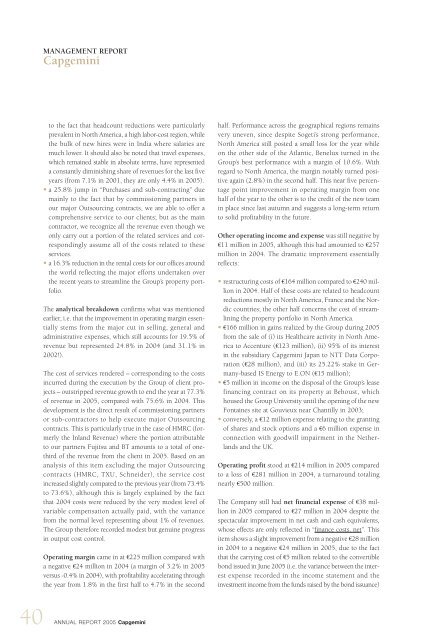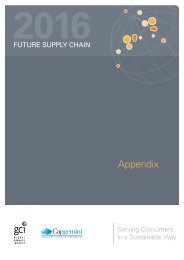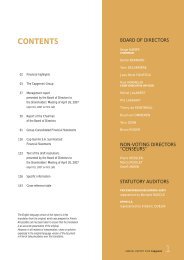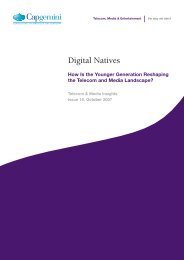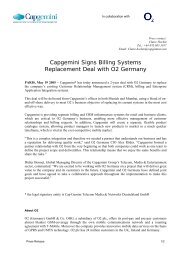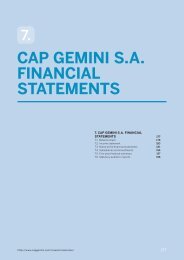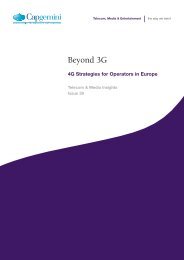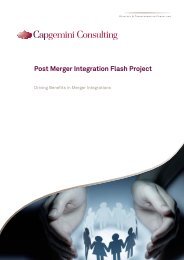You also want an ePaper? Increase the reach of your titles
YUMPU automatically turns print PDFs into web optimized ePapers that Google loves.
40 ANNUAL<br />
MANAGEMENT REPORT<br />
<strong>Capgemini</strong><br />
to the fact that headcount reductions were particularly<br />
prevalent in North America, a high labor-cost region, while<br />
the bulk of new hires were in India where salaries are<br />
much lower. It should also be noted that travel expenses,<br />
which remained stable in absolute terms, have represented<br />
a constantly diminishing share of revenues for the last five<br />
years (from 7.1% in 2001, they are only 4.4% in <strong>2005</strong>).<br />
• a 25.8% jump in “Purchases and sub-contracting” due<br />
mainly to the fact that by commissioning partners in<br />
our major Outsourcing contracts, we are able to offer a<br />
comprehensive service to our clients; but as the main<br />
contractor, we recognize all the revenue even though we<br />
only carry out a portion of the related services and correspondingly<br />
assume all of the costs related to these<br />
services.<br />
• a 16.3% reduction in the rental costs for our offices around<br />
the world reflecting the major efforts undertaken over<br />
the recent years to streamline the Group’s property portfolio.<br />
The analytical breakdown confirms what was mentioned<br />
earlier, i.e. that the improvement in operating margin essentially<br />
stems from the major cut in selling, general and<br />
administrative expenses, which still accounts for 19.5% of<br />
revenue but represented 24.8% in 2004 (and 31.1% in<br />
2002!).<br />
The cost of services rendered – corresponding to the costs<br />
incurred during the execution by the Group of client projects<br />
– outstripped revenue growth to end the year at 77.3%<br />
of revenue in <strong>2005</strong>, compared with 75.6% in 2004. This<br />
development is the direct result of commissioning partners<br />
or sub-contractors to help execute major Outsourcing<br />
contracts. This is particularly true in the case of HMRC (formerly<br />
the Inland Revenue) where the portion attributable<br />
to our partners Fujitsu and BT amounts to a total of onethird<br />
of the revenue from the client in <strong>2005</strong>. Based on an<br />
analysis of this item excluding the major Outsourcing<br />
contracts (HMRC, TXU, Schneider), the service cost<br />
increased slightly compared to the previous year (from 73.4%<br />
to 73.6%), although this is largely explained by the fact<br />
that 2004 costs were reduced by the very modest level of<br />
variable compensation actually paid, with the variance<br />
from the normal level representing about 1% of revenues.<br />
The Group therefore recorded modest but genuine progress<br />
in output cost control.<br />
Operating margin came in at €225 million compared with<br />
a negative €24 million in 2004 (a margin of 3.2% in <strong>2005</strong><br />
versus -0.4% in 2004), with profitability accelerating through<br />
the year from 1.8% in the first half to 4.7% in the second<br />
REPORT <strong>2005</strong> <strong>Capgemini</strong><br />
half. Performance across the geographical regions remains<br />
very uneven, since despite Sogeti’s strong performance,<br />
North America still posted a small loss for the year while<br />
on the other side of the Atlantic, Benelux turned in the<br />
Group’s best performance with a margin of 10.6%. With<br />
regard to North America, the margin notably turned positive<br />
again (2.8%) in the second half. This near five percentage<br />
point improvement in operating margin from one<br />
half of the year to the other is to the credit of the new team<br />
in place since last autumn and suggests a long-term return<br />
to solid profitability in the future.<br />
Other operating income and expense was still negative by<br />
€11 million in <strong>2005</strong>, although this had amounted to €257<br />
million in 2004. The dramatic improvement essentially<br />
reflects:<br />
• restructuring costs of €164 million compared to €240 million<br />
in 2004. Half of these costs are related to headcount<br />
reductions mostly in North America, France and the Nordic<br />
countries; the other half concerns the cost of streamlining<br />
the property portfolio in North America.<br />
• €166 million in gains realized by the Group during <strong>2005</strong><br />
from the sale of (i) its Healthcare activity in North America<br />
to Accenture (€123 million), (ii) 95% of its interest<br />
in the subsidiary <strong>Capgemini</strong> Japan to NTT Data Corporation<br />
(€28 million), and (iii) its 25.22% stake in Germany-based<br />
IS Energy to E.ON (€15 million);<br />
• €5 million in income on the disposal of the Group’s lease<br />
financing contract on its property at Behoust, which<br />
housed the Group University until the opening of the new<br />
Fontaines site at Gouvieux near Chantilly in 2003;<br />
• conversely, a €12 million expense relating to the granting<br />
of shares and stock options and a €6 million expense in<br />
connection with goodwill impairment in the Netherlands<br />
and the UK.<br />
Operating profit stood at €214 million in <strong>2005</strong> compared<br />
to a loss of €281 million in 2004, a turnaround totaling<br />
nearly €500 million.<br />
The Company still had net financial expense of €38 million<br />
in <strong>2005</strong> compared to €27 million in 2004 despite the<br />
spectacular improvement in net cash and cash equivalents,<br />
whose effects are only reflected in “finance costs, net”. This<br />
item shows a slight improvement from a negative €28 million<br />
in 2004 to a negative €24 million in <strong>2005</strong>, due to the fact<br />
that the carrying cost of €5 million related to the convertible<br />
bond issued in June <strong>2005</strong> (i.e. the variance between the interest<br />
expense recorded in the income statement and the<br />
investment income from the funds raised by the bond issuance)


